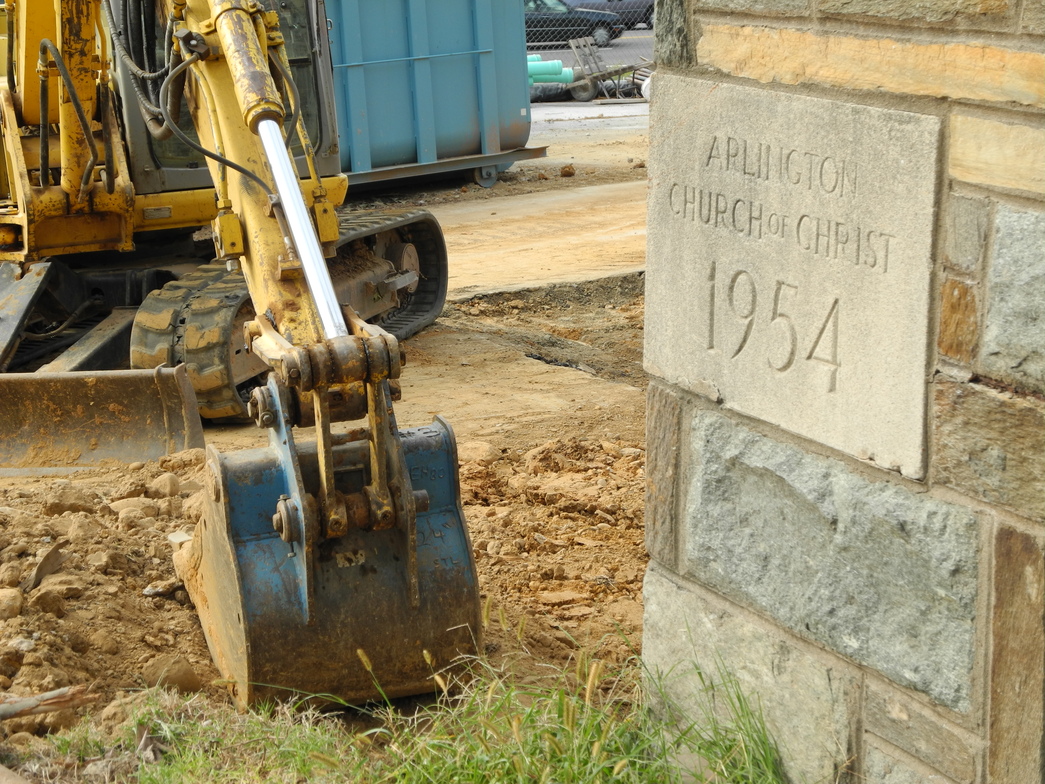Remember the Past of Christian History


“Remember the days of old; consider the generations long past. Ask . . . your elders, and they will explain to you.” Deut. 32:7.
Ten years ago this week, our congregation celebrated the completion of our meetinghouse’s renewal and expansion. See photo above showing backhoe digging for the expansion. We financed about a third of the cost of this project with a $1.3 million loan, repayment of which the congregation completed this past July. These achievements, however significant in our congregation’s history, count for little in Christianity’s broader narrative.
To grasp where we have come from, who we are and where we may be headed, we need a much broader perspective. For that, I urge you to read Diarmaid MacCulloch, Christianity: The First Three Thousand Years (2010). The book chronicles “the sheer variety of Christianity from its earliest days” and from this diversity questions “impos[ition] [of] a uniformity on Christian belief and practice . . . .” Id. 176. Here are a few points from this book’s third, fourth and fifth chapters.
The collected writings that we call the New Testament begin with four accounts of ordinary people’s experiences (for the time, a 'down-market' variety of biography) with a Jewish rabbi from Nazareth. These “gospels” (a later-coined term) describe how this Jesus transcended Jewish expectations and present his universal destiny as the world’s savior.
As this message spread, some Jewish communities of Jesus’ followers began to accept non-Jews sympathetic to certain Jewish theological principles. The Apostle Paul urged their inclusion despite considerable controversy, especially over whether these converts needed to adopt Jewish practices. Paul’s surviving writings focus on the effect of Jesus’ death and resurrection in God's cosmic plan. Paul used the word “Church” to describe both local gatherings and the body uniting all believers and distinguished its practices by a common meal (the Lord’s Supper) and baptism. Faith communities following these practices inherited Christianity’s future as Jewish-Christian communities gradually declined, especially with the repeated destruction by Roman authorities of Jerusalem.
In most respects, early Christianity did not pose a radical challenge to the Roman world’s existing social hierarchies. Paul's writings sometimes list women (like Phoebe and Junia) as holders of important church positions but otherwise support traditional hierarchies (within families by identifying the husband as head of his wife). Generally, Paul accepted the secular status quo (including the existence of slavery) because he and his followers assumed the world was ending soon. While the early Church initially gave women active roles, it gradually moved toward their more conventional subordination to male authority.
Early Christian communities usually met in homes because they lacked structures dedicated to Church use for these meetings. Between 233 and 256 CE, one such house was converted for use as a dedicated space for Christian worship (details here); this is the earliest surviving dedicated Christian meeting place now known to archaeologists. A flood in 201 CE destroyed the one earlier, known dedicated Christian meeting place.
In subsequent decades, to avoid persecution and further the Church's public image as a respectable, non-subversive organization, its leaders developed three main tools. They formulated an agreed list of authoritative texts (with the earliest complete list acknowledged as the final New Testament as late as 367 CE). With considerable controversy, Church leaders hammered out short formulations of belief, which took on an increasingly aggressive tone to counter growing diversity. They identified ministers and empowered them with authority.
MacCulloch’s book covers far more than this little summary will attempt to detail. It explores Christianity’s roots in Greek philosophy. It describes Christianity’s spread across many locations, including northern Africa, Iraq and Iran, India and China. It chronicles the rise of Islam and its overlapping concepts and conflicts with Christianity. It recounts the history of the Orthodox church in what are now Türkiye, Greece and Russia. It explains the controversies and consequences of the Reformation in western Christendom. Unsurprisingly, a book of such breadth requires many pages (in hardcover, 1184).
On January 13, 2026, starting at 7 pm Eastern time, the Reading Circle (RC) will begin its discussion of Christianity: The First Three Thousand Years via Zoom at this link. Information about this small group and others in our congregation is at Small Groups | Arlington Church of Christ. I encourage your participation, including in RC even if you have not read the book.